�
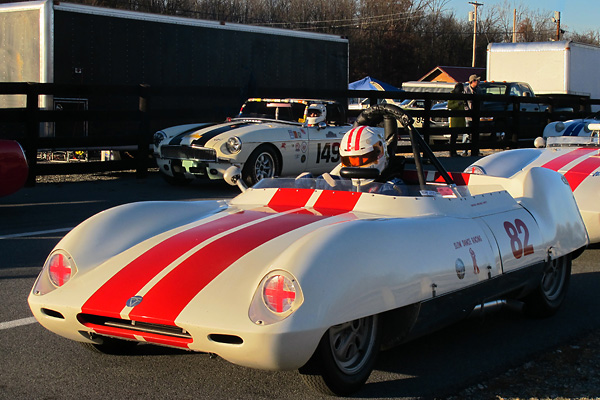
�
Michael Oritt's 1959 Elva MkIV Racecar
� � Owner: Michael Oritt� City: Saint Leonard, Maryland
� Model: 1959 Elva MkIV
� Engine: Coventry Climax FWE, 1216cc
� Race prepared by: Michael Clifford �
�
Elva Engineering Co. Ltd. Focused on the Export Market
��
The first three models of Elva Engineering Co. racecars were designed for proprietor�
Frank Nichols by chief mechanic Malcolm "Mac" Witts. Another mechanically gifted friend of�
Frank Nichols named Keith Marsden was hired to help assemble the cars. When Witts left the�
firm in early 1957, Marsden became responsible for design. Marsden's first task was to�
refine the newly designed Elva MkIII and get it into production. (His main change was conversion�
to a de Dion rear suspension.) The MkIII was produced through 1958, while Marsden focused on�
designing and developing its successor. Although self taught, Marsden quickly proved one of�
the most formidable racecar designers of his era. Marsden would remain Elva's principle designer of�
racecars through Elva's Mk7 (circa ~1964). Concurrently, Peter Knott had primary responsibility�
for designing Elva's Courier sports car model. Marsden left the company in July 1964 when�
Elva was taken over by Trojan. He went on to a long career at Ford of Britain.�
�
Elva Engineering Co. Ltd. was a relatively small firm that operated in the shadows of Lotus.�
From early 1956 through 1958, the�
Lotus Eleven�
model completely dominated small displacement "Sports" racing classes throughout the UK and�
Europe. Lotus promoted their Eleven model by recruiting well known professional drivers and�
entering them in important races like Le Mans. Meanwhile, Elva quietly built a reputation for�
robust and easy-to-drive cars that were priced competitively. Elva only fielded works teams�
in a handful of races. Elva's cars were raced in England, but the lion's share of production�
was shipped to North America. A particularly well respected SCCA racer (and car dealer) named�
Chuck Dietrich bought an Elva MkII in 1956 and enjoyed excellent success with it. As Elva's�
reputation spread, the small firm planned and prepared to pass Lotus in this important export�
market. �
�
Two prototypes of Keith Marsden's first complete racecar design, the new Elva MkIV model, began�
appearing in occasional British races during 1958. One MkIV was entered in the Tourist Trophy�
endurance race at Goodwood (13 September 1959) as was Eric Broadley's brand new�
Lola Sports Mk1,�
but neither car finished well that day. �
�
The MkIV model's first really important appearance was on 21 March 1959, when works entered�
Elva MkIVs finished first and second place in the 1100cc class of the 12 hours of Sebring endurance�
race. The 19th-place overall #48 Elva was driven by Frank Babtista and Arthur Tweedale.�
The 23rd-place overall #49 Elva was driven by William Jordon and Chuch Dietrich. The Lotus works�
team entered one 1.1L Eleven in that race, but it finished way back in 47th place. (Incidentally�
Phil Hill, Olivier Gendebien, Dan Gurney and Chuck Daigh all shared the race winning�
Ferrari which ultimately prevailed over the Stirling Moss / Ivor Bueb�
Lister-Jaguar.)�
�
Just one week later, Tommy Dickson entered an Elva MkIV in Easter Monday's Sports 1.1 race�
at Goodwood. Dickson out-qualified all three of the Lotus Elevens entered, but ultimately logged�
a DNF for the race. Dickson was himself out-qualified by three Lola Sports Mk1s which went�
on to sweep the podium.�
�
The Sebring and Easter Monday (Goodwood) results epitomize 1959: Lotus had been swept aside in�
the 1.1L classes, but by two different firms with eyes on two very different markets. Lola's�
Sports Mk1 was now the racecar to have on one side of the Atlantic, and Elva's MkIV was the car�
to have on the other. �
�
 �
�
�
�
Key Features of the Elva MkIV Model
��
The Elva MkIV featured an all new frame design, constructed of 1" and 3/4" diameter 20-gauge�
mild steel tubing. According to the company's press announcements each MkIV frame weighed just�
39 pounds. The MkIV frame is notably simple and symmetrical in form compared to the car's main�
rivals. Many years after the MkIV was built, designer Keith Marsden explained a more�
subtle but still important fabrication difference between Elva MkIV frames and those of rival�
cars: fusion-welded joints. In England it was generally standard practice to use silver-bronze�
filler rod when "welding" frame joints. In North America we don't call that welding, we call it�
"brazing." In America it was more common to use steel filler rod. There's a case to be made for�
either practice. In Marsden's view, the structural differences between the two types of joint�
were academic; he preferred fusion welding because he considered visual quality inspection of�
fusion-welded joints to be more reliable. �
�
Possibly the single most important aspect of Keith Marsden's Elva MkIV design was his placement�
of the Coventry Climax engine. He put the engine 5.5 inches further back from where it had been�
in Elva's MkIII model. From the centerline of the front wheels back to the first spark plug hole�
measures about 21 inches. The engine couldn't have been mounted further back without utilizing a�
different gearbox; the MGA gearbox is so close to the rear differential that there's no room for�
a prop-shaft. Instead, a special double U-joint device was used. The effect of this engine placement�
is important: the MkIV has an uncommonly rearward weight bias (about forty/sixty front to rear,�
depending on customer specifications) and also the car has a lower polar moment of inertia than�
rivals. Thus, the MkIV is particularly suited for tight, twisty courses where its nimbleness can�
be exploited.�
�
The MkIV suspension was state-of-the-art for its day: fully independent and particularly tunable�
with Armstrong single-adjustable coilover shock absorbers as standard equipment. Elva produced�
their own steering racks, which were a contributing factor to the car's characteristically light�
steering feel. In a few notable ways, the MkIV is quite similar to the Lola Mk1. At the rear, both�
designs utilized fixed-length driveshafts in conjunction with inboard brakes. Designers Keith Marsden�
and Eric Broadley were both keen to minimize unsprung weight. (Effect: tires maintain better contact�
with the road, especially over bumps.) Both designers also chose drum brakes. This may seem�
counter-intuitive, but in 1959 drum brakes could be an advantage on very lightweight cars where�
brake fade was less of an issue: pedal feel was deemed lighter and easier for the driver to modulate�
and brake bias was deemed easier to fine tune in light of the pad/lining compounds of the day.�
Both front and rear, the MkIV suspensions are quite novel in detail and geometry. To save thousands�
of words, we'll direct interested readers to the photos and captions below.�
�
�
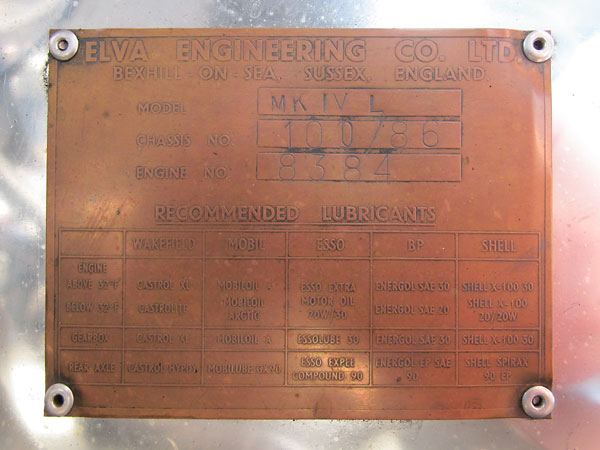
�
Elva Engineering Co. Ltd. - Bexhill-On-Sea, Sussex, England.
�
Model MK IV L - Chassis No. 100/86 - Engine No. 8384
�
Michael Oritt's Elva MkIV Model - Chassis 100/86
��
About thirty-two Elva MkIV cars were built. Chassis numbers are known to start at about 100/63 and�
run to about 100/90. We don't know the anomalies of Elva's numbering system; like other constructors�
they offered the model as either a completed car or as a kit and they also offered replacement�
frames. What does the "L" designation mean? The wheelbase is three or four inches longer than most�
other MkIVs, for more comfortable accommodation of tall drivers.�
�
Michael Oritt has no information on chassis number 100/86's history or ownership prior to�
1990 when a VSCCA logbook was issued to Tom Elsworth. Elsworth sold the car to Tom Grudovich�
in about 2004, and Tom Grudovich sold the car to Michael Oritt in 2008.�
�
Like most Elva MkIV racecars, chassis number 100/86 was originally powered by a Coventry Climax�
FWA 1098cc engine which was later converted to FWE 1216cc specs. The immediate previous owner,�
Tom Grudovich, then re-powered the MkIV with a Coventry Climax FWB 1460cc engine and raced it�
for several years. He sold the car to Michael Oritt with the FWE. (The FWB engine is now used�
in Tom's Lola Sports MkI.) Michael is in the process of building a different FWB engine for the�
Elva MkIV. �
�
Please support the sponsoring companies who make www.BritishRaceCar.com possible, including:
� �
 �
�
�
�
Features and Specifications
�| Engine: | �Coventry Climax FWE (4 cylinder SOHC, 1216cc).�
Coventry Climax stage-4 camshaft.�
Dual Weber 40DCOE carburetors.�
Weber TLK1/W throttle linkage assembly.�
K&N oiled gauze air filters.�
Lucas distributor with Pertronix solid state module.�
Magnecor KV85 Competition spark plug wires.�
Pertronix Flame-Thrower ignition coil, 3.0 ohm.�
K&N HP-3001 oil filter, on a Moroso remote base. | �
| Cooling: | �custom aluminum crossflow radiator.�
Electric cooling fan.�
Setrab oil cooler (part# 50-616-7612). | �
| Exhaust: | �custom 4-into-1 header, Jet-Hot coated inside and out.�
Glasspack muffler. | �
| Transmission: | �MGA 4-speed, 3 synchro close ratio helical gear set.�
Tilton hydraulic throw-out bearing.�
Note: transmission connected directly to differential with only a vestigial prop shaft with twin universal joints. | �
| Rear End: | �Elva magnesium housing (sized for BMC A components).�
Salisbury-type limited slip differential.�
4.55:1 ring and pinion. | �
| Front Susp.: | �modified twin-wishbone independent suspension via �
upper radius arms braced rearward with diagonal stays anchored to rubber discs and�
lower radius arms braced rearward by the non-adjustable anti-roll bar.�
Supplemental rearward braces have been added underneath the anti-roll bar.�
Alford & Alder (Triumph Herald pattern) forged steel uprights.�
Carrera steel body coilover shock absorbers.�
Elva proprietary steering rack (12:1 ratio, 1.25 turns), mounted behind wheel centerline. | �
| Rear Susp.: | �independent suspension via�
fixed length (11.5") driveshafts combined with lower transverse links (13.5")�
and long box-section longitudinal links.�
�
Carrera steel body coilover shock absorbers. | �
| Dimensions: | �7' 4" wheelbase. 42/58 weight distribution. 3' 10.5" track. | �
| Brakes: | �(master) one Lockheed master cylinder plus one Wilwood remote reservoir master cylinder. Adjustable bias bar. � (front) customized Nissan 9" brakes with finned aluminum drums. Vented backing plates. � (rear) Lockheed 10" x 1.75" brakes with iron-lined magnesium drums. Vented backing plates. | �
| Wheels/Tires: | �Elva cast magnesium wheels (15x4 front and 15x4.50 rear). �
Dunlop 204-L tires (15x4.50 front and 15x5.00 rear). | �
| Electrical: | �12 volt lead/acid battery.�
Gear reduction starter. | �
| Instruments: | �(left to right)�
Auto Meter SportComp tachometer (0-10,000rpm),�
oil temperature gauge (140-280F),�
oil pressure gauge (0-100psi), and�
water temperature gauge (120-240F).�
(An Auto-Meter hour meter is mounted out of sight.) | �
| Fuel System: | �original style cylindrical aluminum 8 imperial gallon (9.6 U.S. gallon) fuel tank.�
Facet cube-type solid state fuel pump. | �
| Safety Eqmt: | �Racequip 5-point cam-lock safety harness.�
Bicknell Racing Products quick release steering wheel hub on a Mountney steering wheel.�
Firebottle centralized fire suppression system.�
SPA Design Sports Car rear view mirror.�
GT Classic side view mirror. | �
| Weight: | �~1045 pounds, wet. | �
| Racing Class: | �G Modified. | �
Engine Installation
��
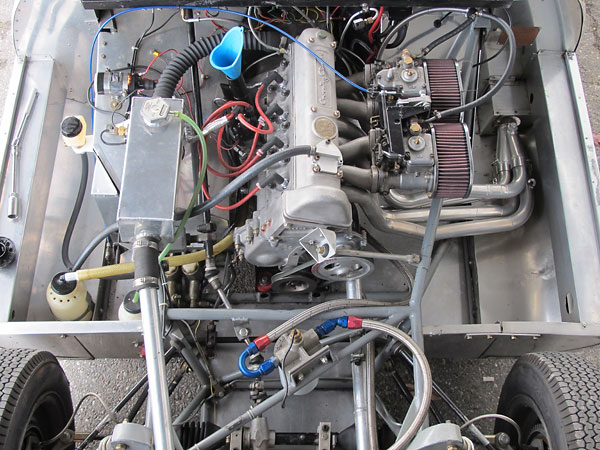
�
Coventry Climax FWE four cylinder, single overhead camshaft, 1216cc engine.
�
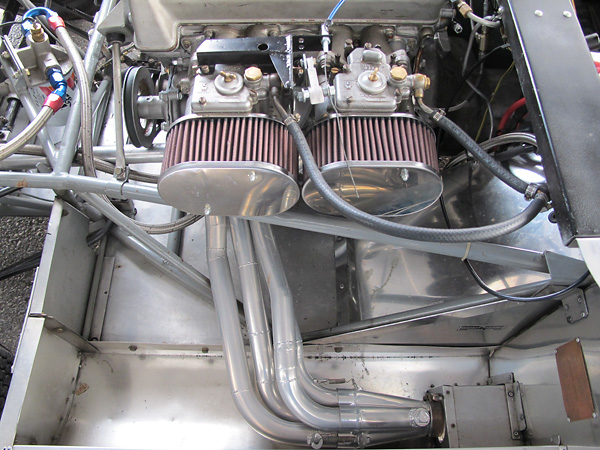
�
Dual Weber 40DCOE carburetors with K&N oiled gauze air filters. Note that a boss has
�
been welded onto the exhaust header collector for installation of an oxygen sensor,
�
which is a tremendous aid when adjusting the carburetors and ignition system.
�
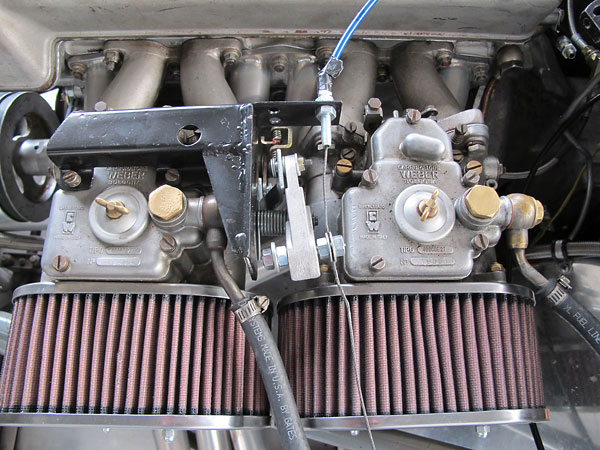
�
Weber TLK1/W throttle linkage assembly.
�
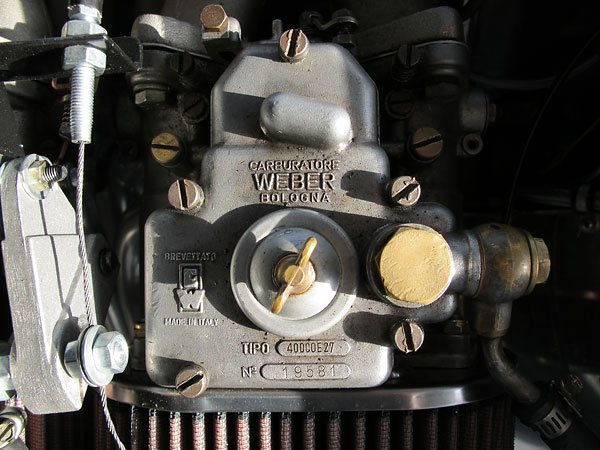
�
Weber Carburatore, Bologna - Tipo: 40DCOE27 - No: 19581.
�
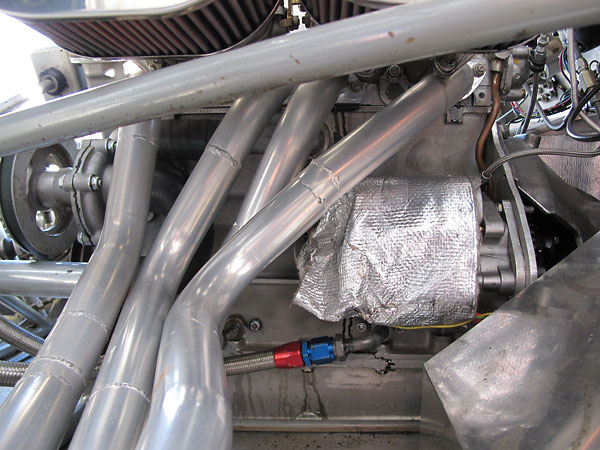
�
Gear reduction starter.
�
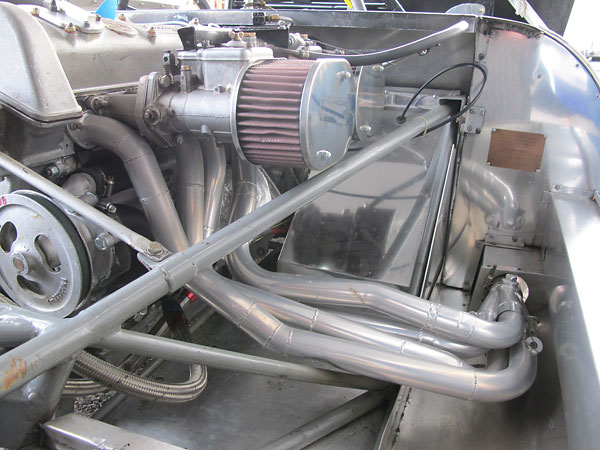
�
Custom 4-into-1 header, Jet-Hot coated inside and out.
�
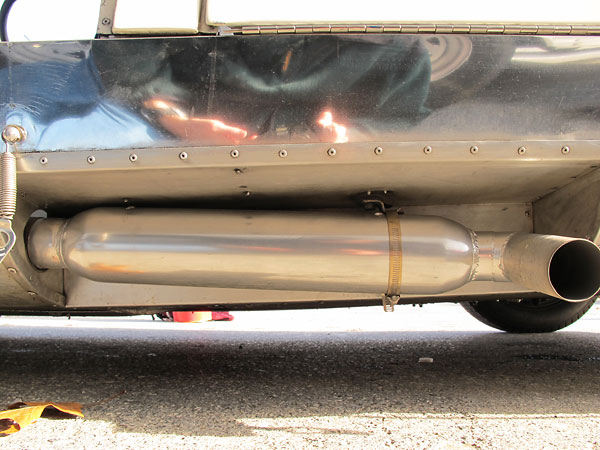
�
Glasspack muffler.
�
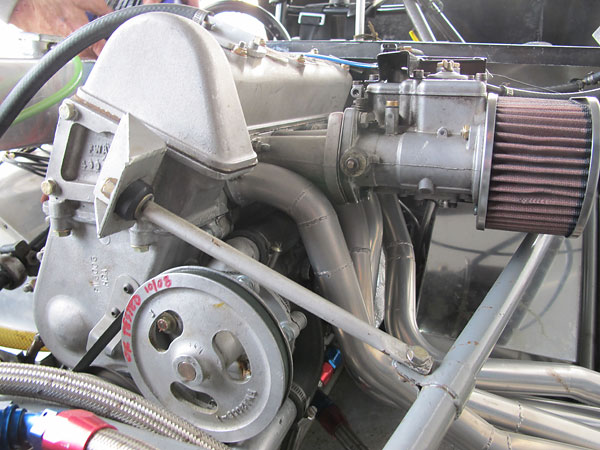
�
Engine steady bar.
�
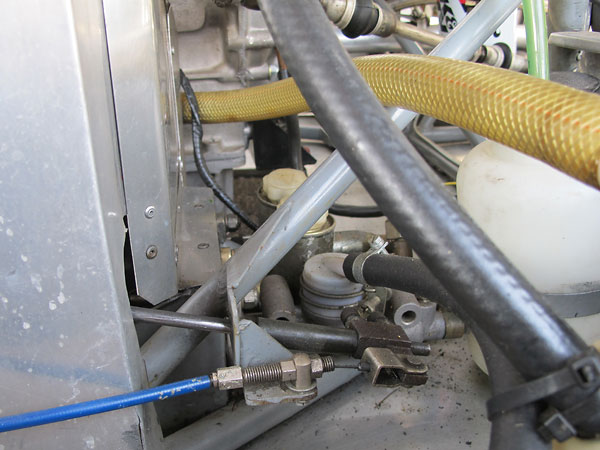
�
There wasn't much room for dual brake master cylinders, but the upgrade was managed by using
�
a Wilwood remote-reservoir cylinder on one side. Note interesting throttle cable installation.
�
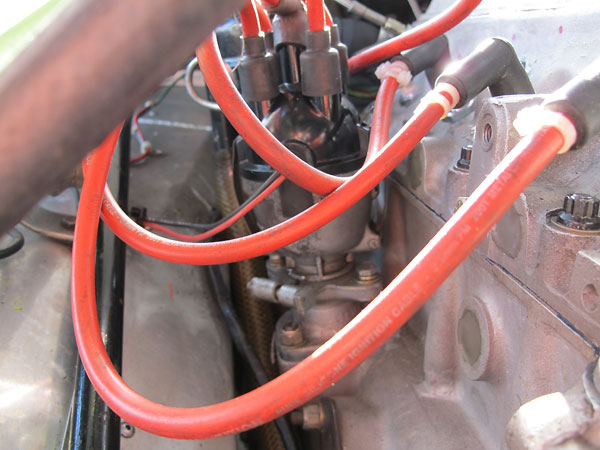
�
Lucas distributor with Pertronix solid state module (inside).
�
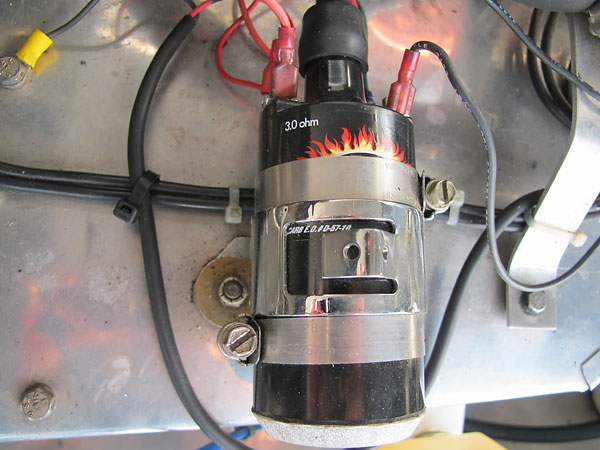
�
Pertronix Flame-Thrower ignition coil, 3.0 ohm.
�
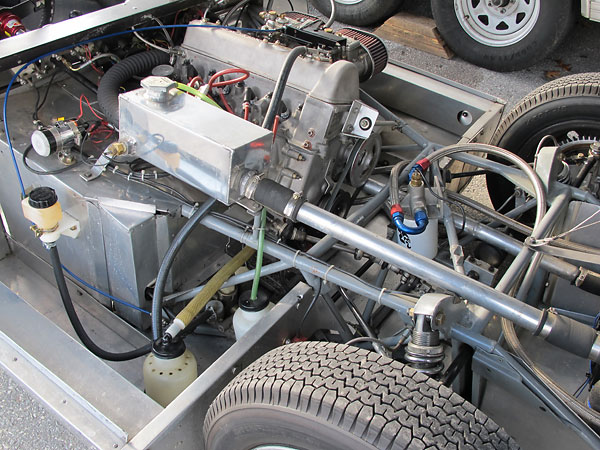
�
Custom fabricated aluminum header tank, located such that its pressurized filler cap
�
is the highest part of the entire cooling system.
�
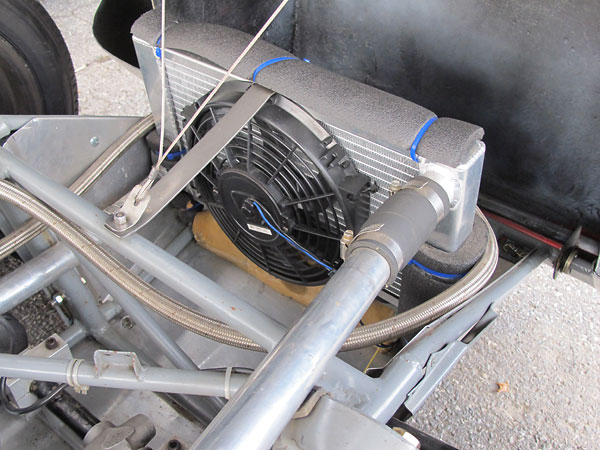
�
Custom aluminum crossflow radiator and electric cooling fan.
�
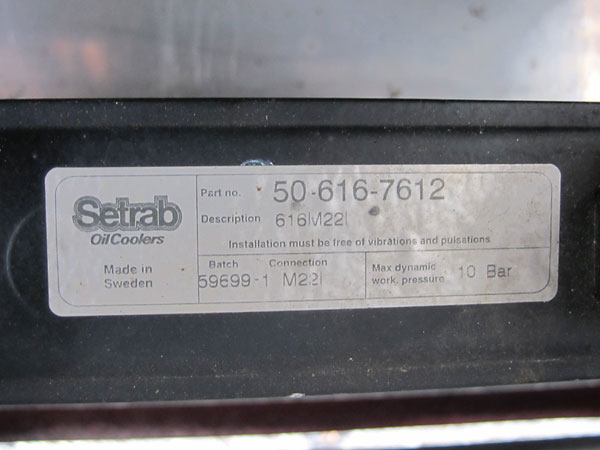
�
Setrab oil cooler (part# 50-616-7612).
�
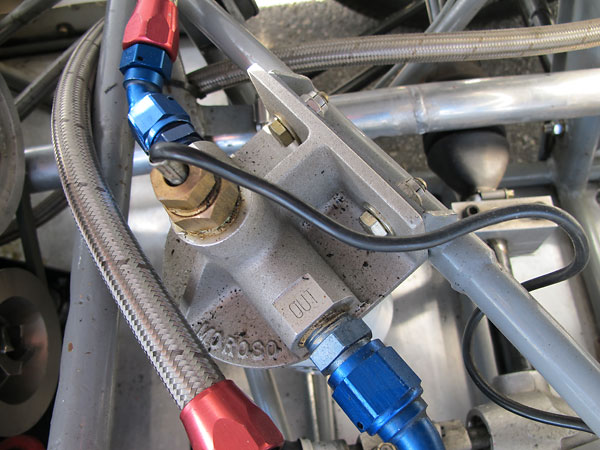
�
Moroso remote oil filter mounting base.
�
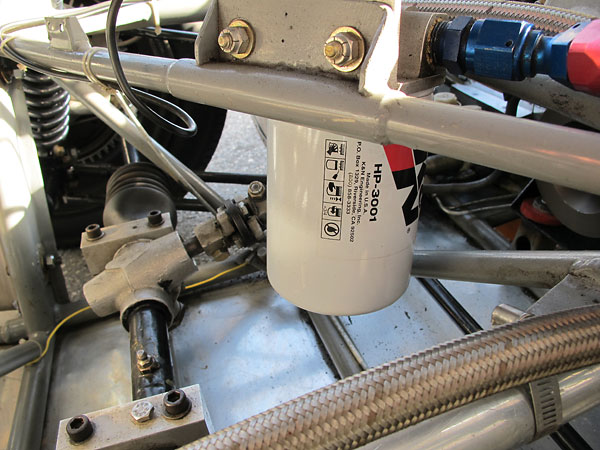
�
K&N HP-3001 oil filter.
�
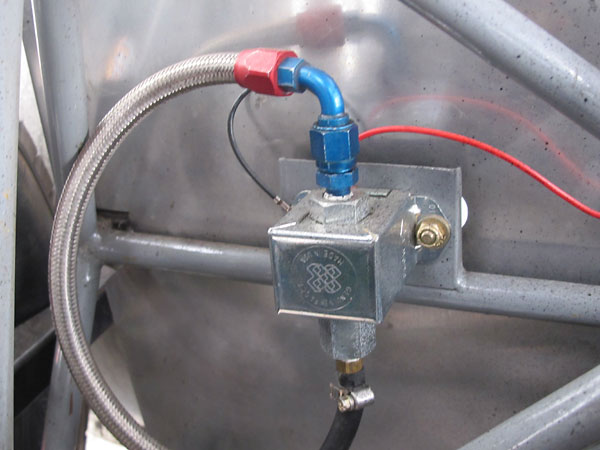
�
Facet cube-type solid state fuel pump.
�
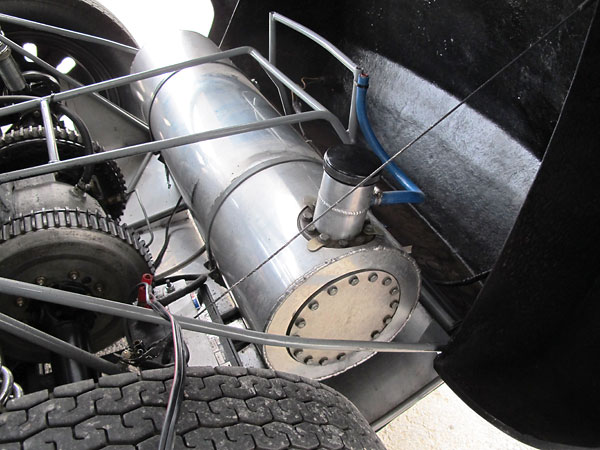
�
Original style cylindrical aluminum 8 imperial gallon (9.6 U.S. gallon) fuel tank.
�
�
IMPORTANT ANNOUNCEMENT
�
BritishRaceCar.com will have to cut back plans for continued growth if we can't find more financial support.
�
If you like what you've found here, and you want to see more, please click here and follow the instructions.
�
Readers like you keep BritishRaceCar.com online and growing through voluntary financial contributions.
�
Front Suspension
��
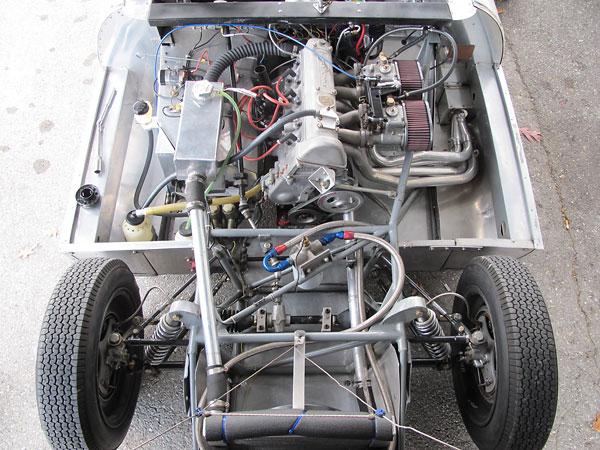
�
Rearward halves of Elva MkIV two-piece upper control arms are anchored to rubber frame mounts.
�
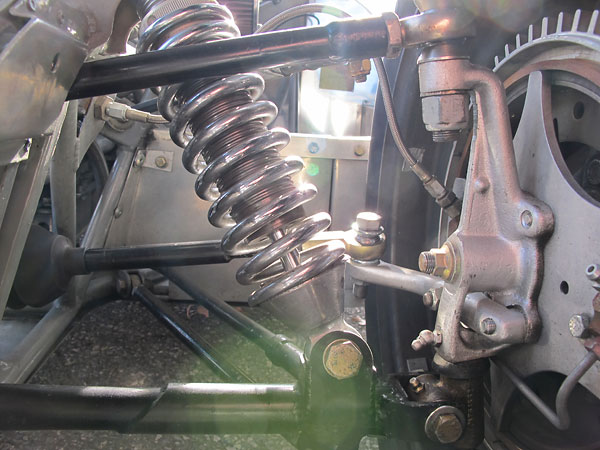
�
Triumph Herald pattern Alford & Alder forged steel uprights are as original. By Elva's
�
original design, anti-sway bar arms functioned as the rearward halves of the lower control
�
arms. Here, supplemental rearward braces have been added underneath the anti-roll bar.
�
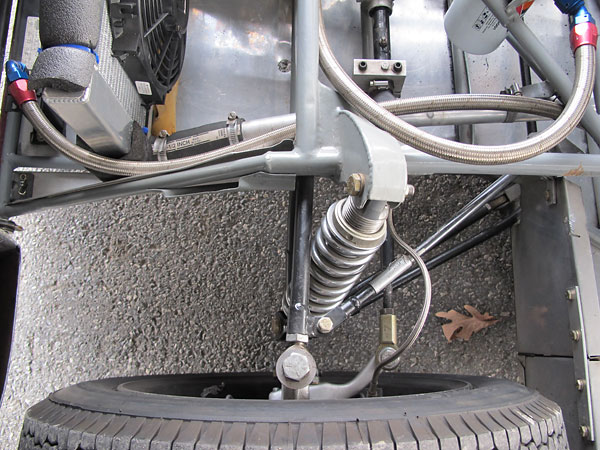
�
Carrera steel body coilover shock absorbers are quite similar to the Armstrong coilovers Elva originally
�
installed. One difference is how the springs are mounted: threaded spring perchs weren't in common
�
use yet, so fine adjustment of ride height and corner weights was more difficult. Also, these Carreras
�
are gas charged, so they can be mounted upside down for a small reduction in unsprung weight.
�
�
Rear Suspension
��
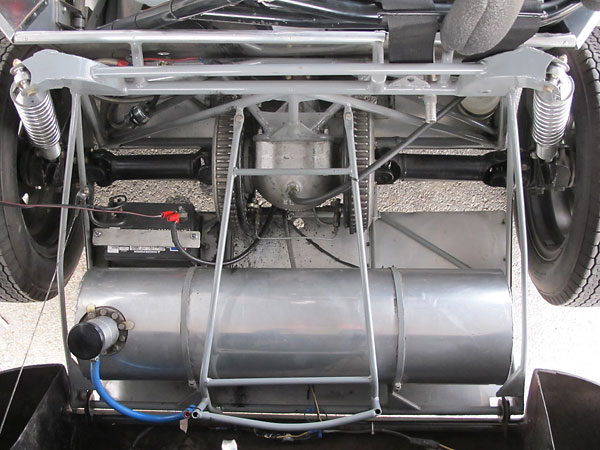
�
All original Elva racecars feature fusion welded frames, principally by a man named Arthur Lee,
�
whereas the tradition in England was to braze spaceframes. Marsden and Lee preferred fusion
�
welding because joint integrity was easier to verify through visual inspection. (Note: the tubular
�
structure above the fuel tank was designed by Marsden to support a spare tire.)
�
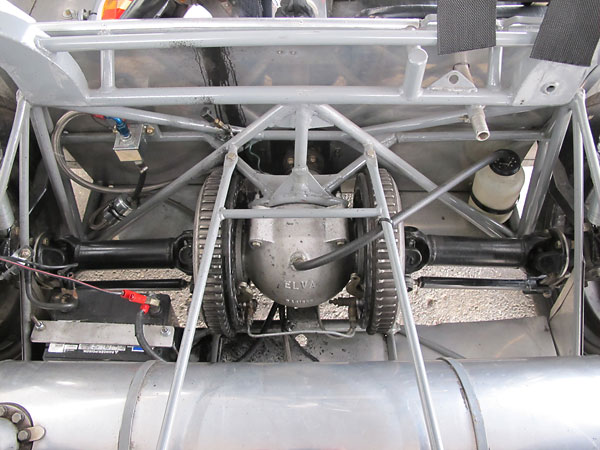
�
Elva's proprietary magnesium rear end housing is sized for BMC A components. Inside?
�
Salisbury-type limited slip differential and a 4.55:1 ring and pinion set.
�
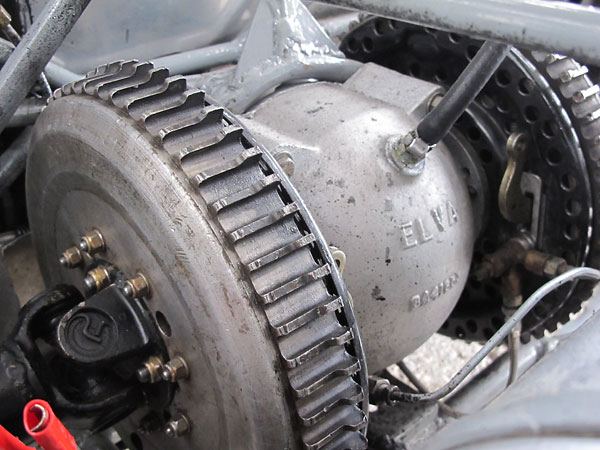
�
Lockheed 10" x 1.75" drum brakes, with (iron lined) magnesium drums and heavily vented backing plates.
�
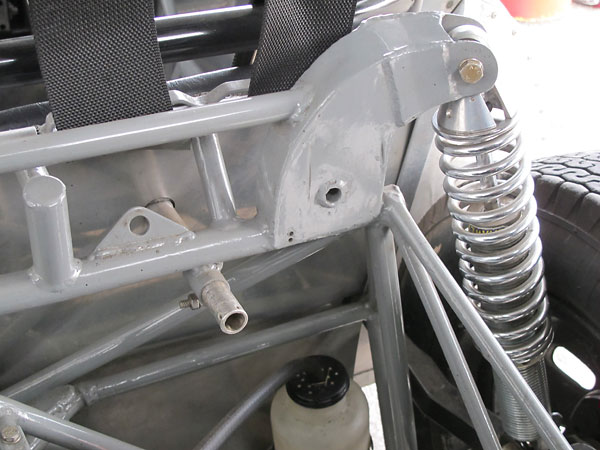
�
Elva recommended that owners set up their MkIVs with two degrees of negative camber, front and rear.
�
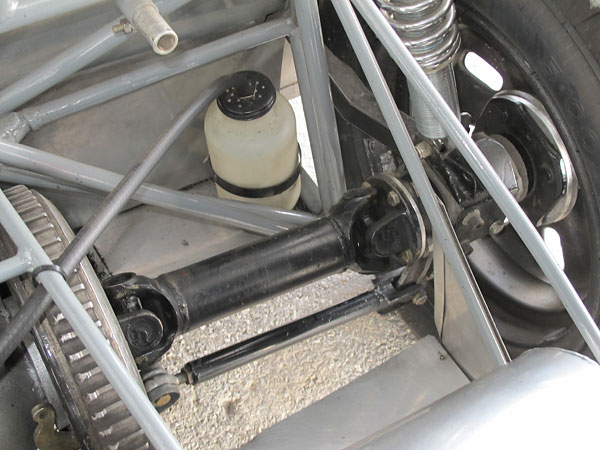
�
Fixed length (~11.5") driveshafts used in combination with lower transverse links (~13.5").
�
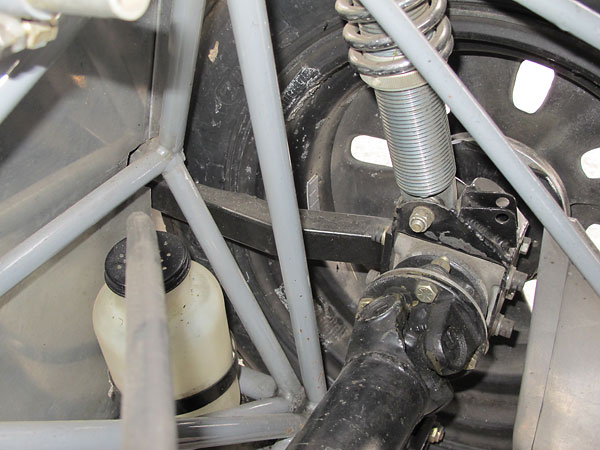
�
Long box-section trailing links...
�
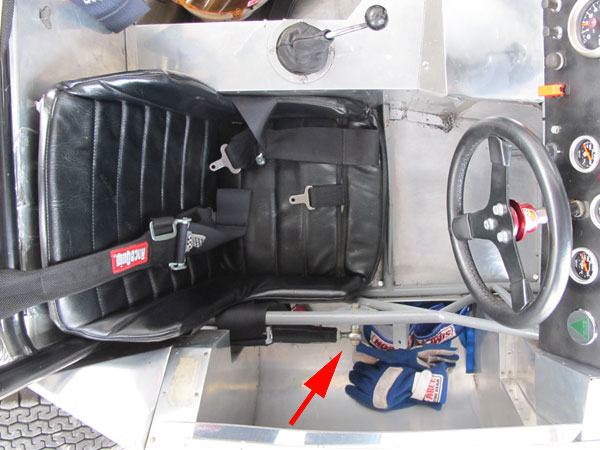
�
...connect quite far forward on the Elva MkIV's tubular frame. There's a big functional advantage
�
to having these links as long as feasible: for a given amount of vertical suspension travel, longer
�
arms provide less fore-and-aft movement and thus cause less roll-steer effect. Note also: Elva
�
facilitated suspension alignment by using threaded rose ("Heim") joints on these links.
�
�
Interior
� �
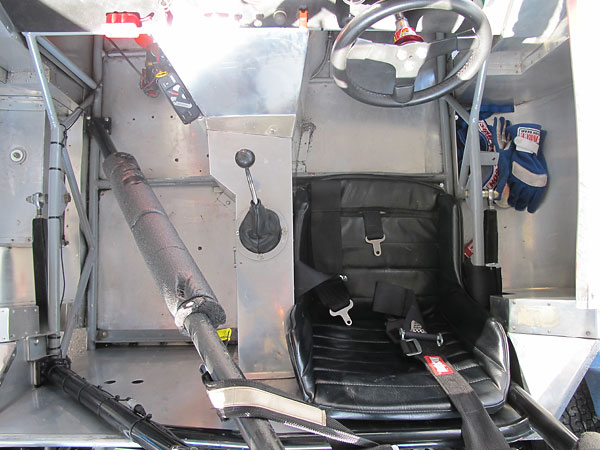
�
The driver's side footbox extends right up beside the engine.
�
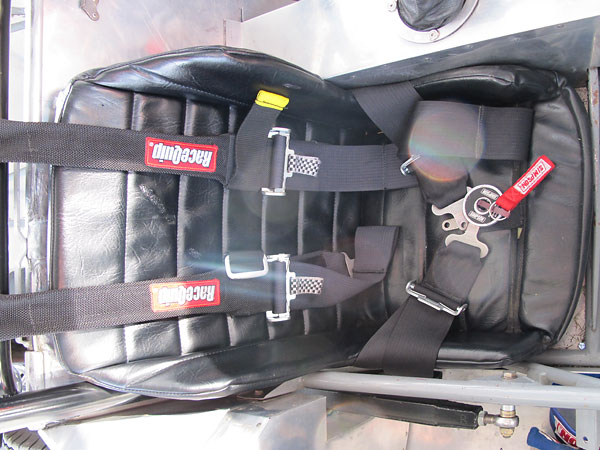
�
RaceQuip shoulder straps used in combination with Simpson Performance Products
�
lap belt and cam-lock buckle mechanism.
�
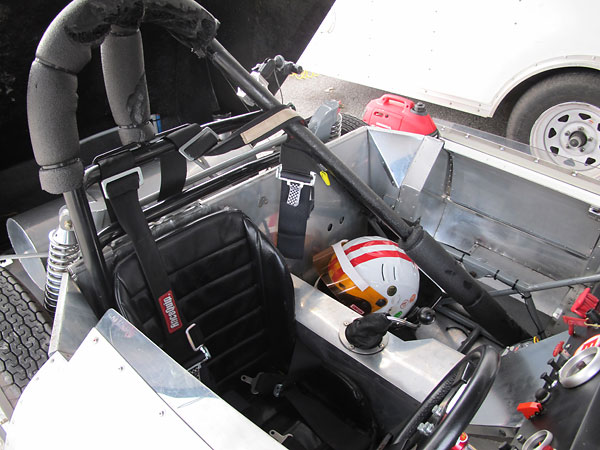
�
The MGA gearbox is mounted so far rearward that a large double kink in its gear shifter is required.
�
This adds a slight up and down movement to gear changes, but I'm told it's easy to get used to.
�
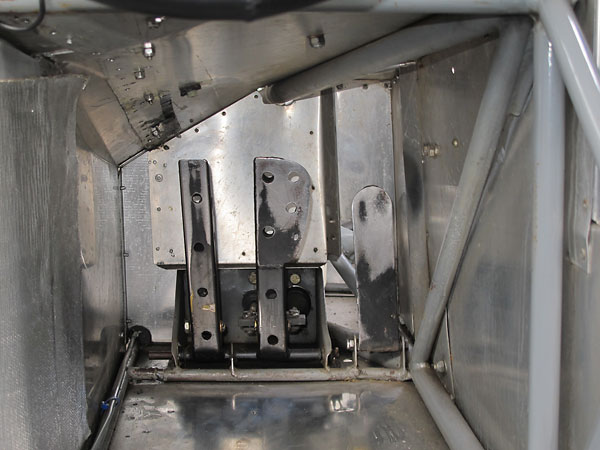
�
This Elva MKIV has been upgraded with dual brake master cylinders with an adjustable bias bar.
�
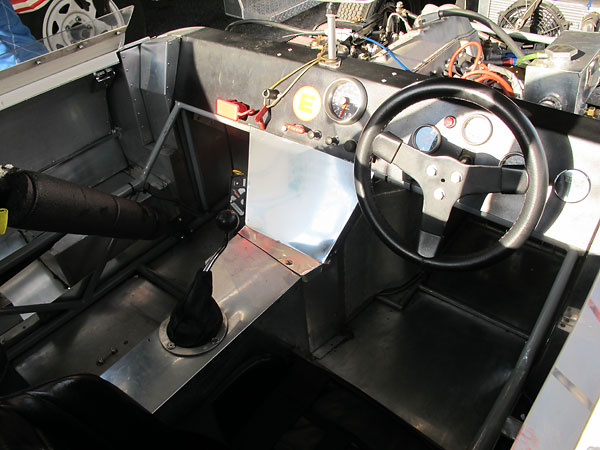
�
Elva MkIVs were provided with right-hand operated parking brake levers. Lever and cable have
�
been removed from this example but you can (just barely) see the lever bracket in this view.
�
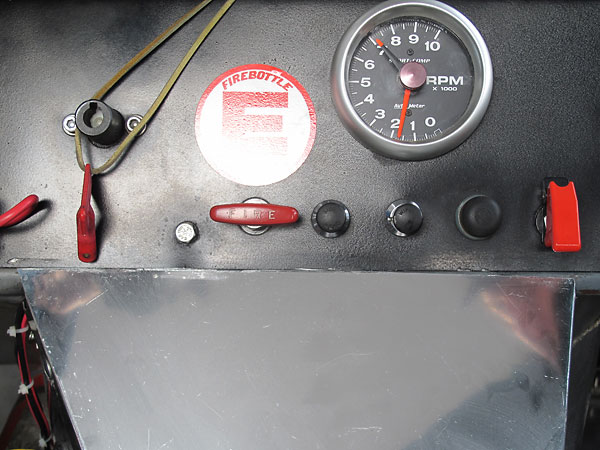
�
Auto Meter SportComp tachometer (0-10,000rpm).
�
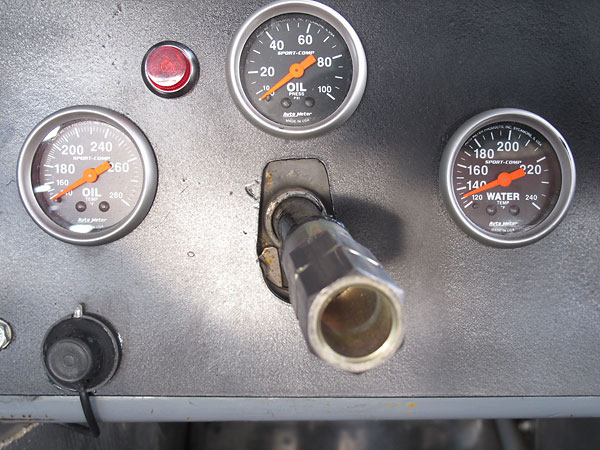
�
Auto Meter SportComp oil temperature, oil pressure, and water temperature gauges.
�
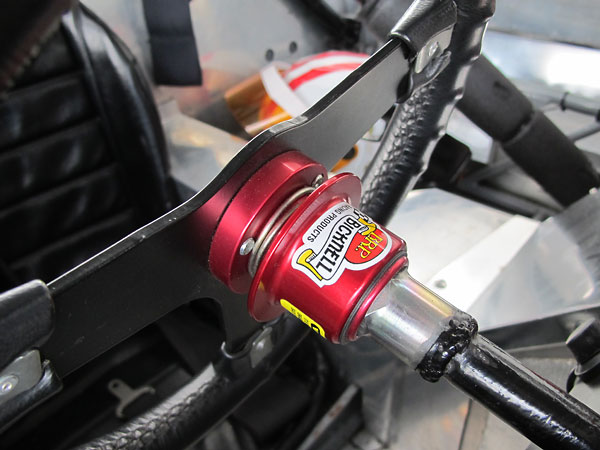
�
Bicknell Racing Products quick release steering wheel hub on a Mountney steering wheel.
�
�
Exterior
� �
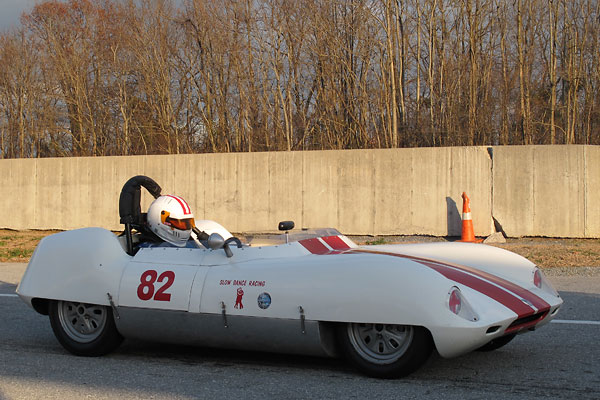
�
Michael Oritt at Vintage Racer Group's 2010 Turkey Bowl, Summit Point Motorsports Park.
�
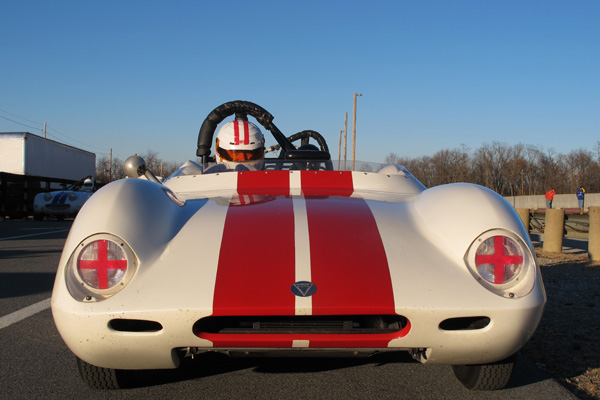
�
1959 National SCCA Championship, G-Modified Class Results: 1st place Arthur Tweedale (Elva MkIV, 64
�
points), 2nd place Frank Baptista (Elva MkIV, 42 points), 3rd place M.R.J. Wyllie (Lotus 11, 34 points).
�
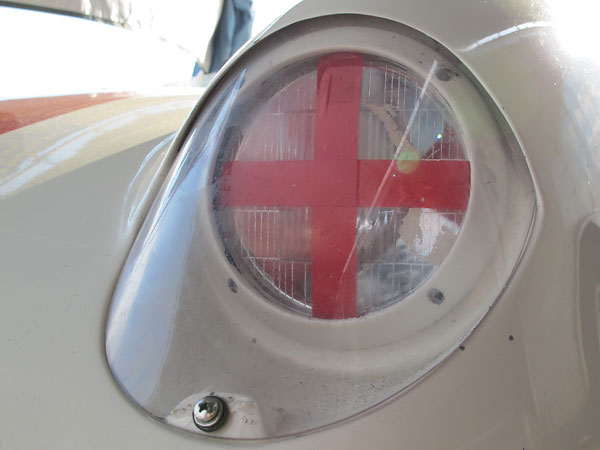
�
Perspex (clear acrylic) headlamp fairings.
�
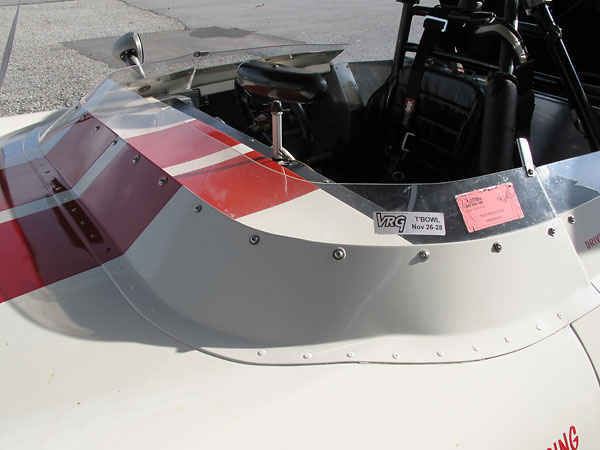
�
Windscreen curvature is both an important and an easily developed aerodynamic feature. As reported
�
by journalist Mike Lawrence, Keith Marsden determined that the "double curvature" shape of the MkIV
�
windscreen was worth 2-3mph on a long straight compared to a simpler, flatter screen. Supposedly,
�
when Colin Chapman saw the MkIV screen he threatened a patent lawsuit but Frank Nichols realized
�
the Lotus patent was only issued in U.K., filed for a U.S. patent, and threatened a counter-suit.
�
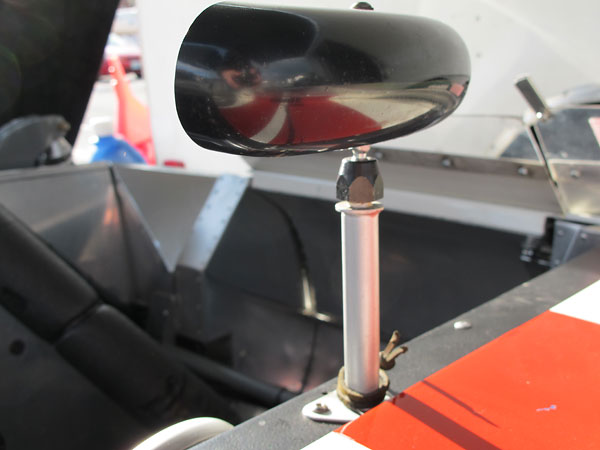
�
SPA Design Sports Car rear view mirror.
�
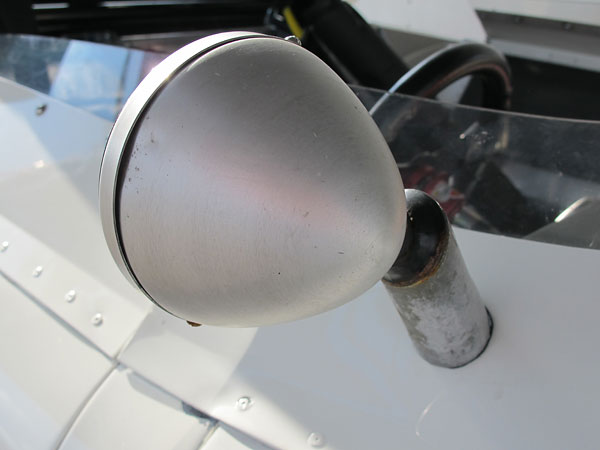
�
GT Classic side view mirror.
�
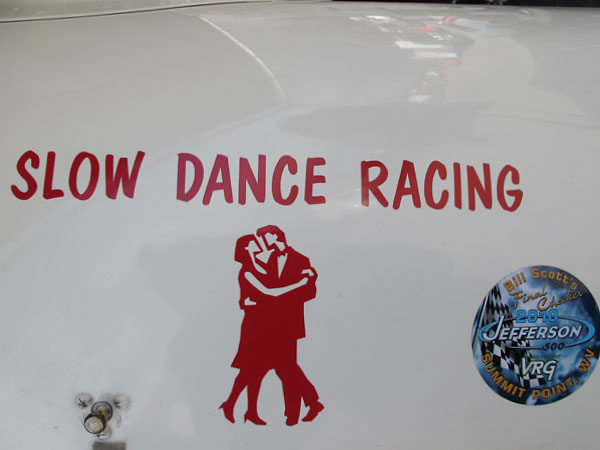
�
Slow Dance Racing
�
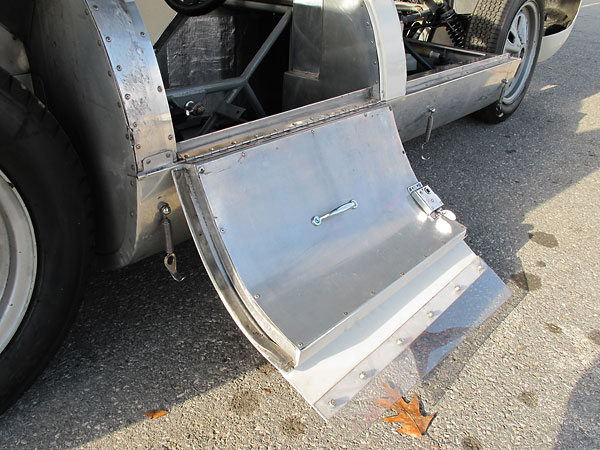
�
Like many vintage sports racers, the Elva MkIV features horizontally hinged doors.
�
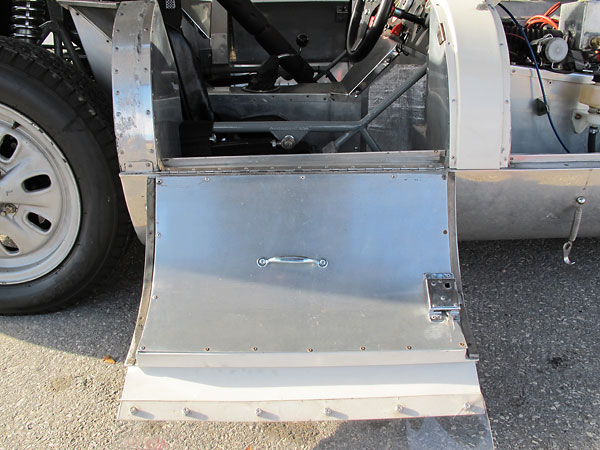
�
Truth be told, it's probably just as easy to enter the car by climbing over the (closed) door,
�
but the presence of functional doors was a rule requirement. Period rules typically also
�
mandated that sports racers be equipped with a passenger seat and a spare tire.
�
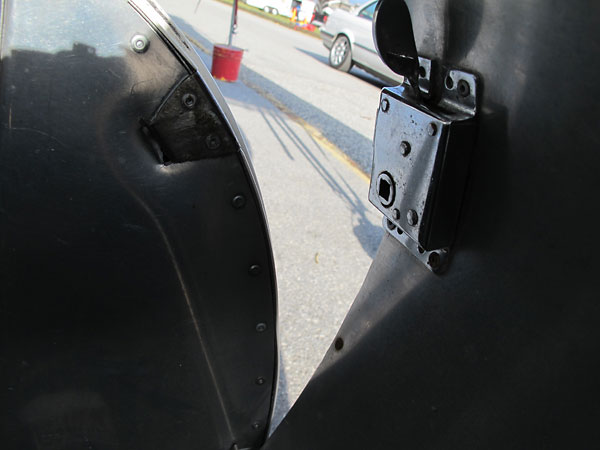
�
"Pudding Spoon" door locks are from the Land Rover parts bin.
�
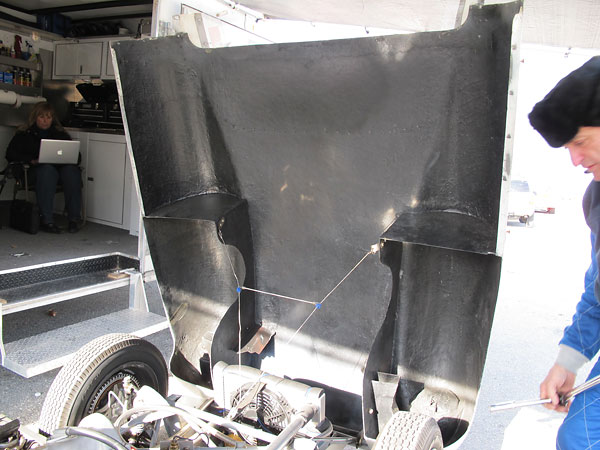
�
The two original MkIV prototypes had aluminum-manganese alloy bodies that weighed just 52#.
�
Production MkIVs came with fiberglass front and rear body sections, in combination with
�
22-gauge alloy panels for the central section, scuttle, doors and floor panels.
�
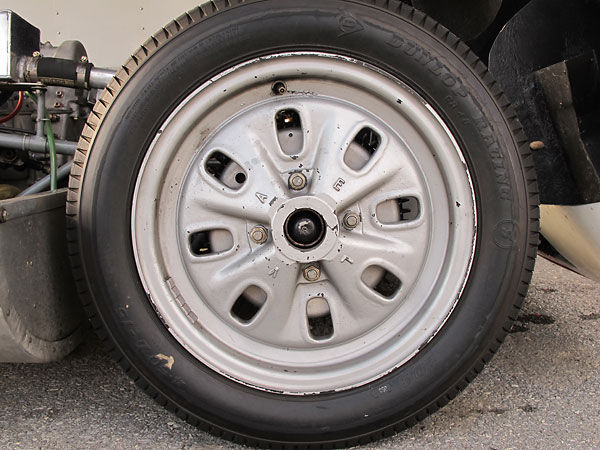
�
Keith Marsden's chief regret with the MkIV design was its wheels (cast magnesium, 15x4 front and
�
15x4.50 rear.) Elva owner Frank Nichols had invested a lot of money in tooling to make 15" wheels
�
so Marsden was obliged to use them. He would have strongly preferred to use wider 13" wheels,
�
but he couldn't justify the additional tooling investment until the Mk7 model.
�
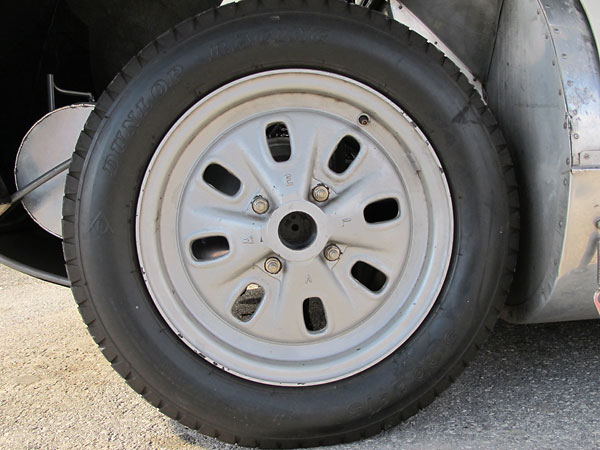
�
Dunlop 204-L tires, 15x4.50 front and 15x5.00 rear.
�
�
Photos shown here are from November 2010 when we viewed the car at the Vintage Racer Group's annual�
Turkey Bowl at Summit Point West Virginia. All photos by Curtis Jacobson for BritishRaceCar.com,�
copyright 2011. All rights reserved.
�
�
| If you liked this article, you'll probably also enjoy these: | �|||||
 | �
Jeff Snook '56 Lotus XI LeMans | �
 | �
Tom Grudovich '60 Lola Sports Mk.1 | �
 | �
Bill Thumel '61 Elva Courier | �
| You're invited to discuss anything you've seen here on The British Racecar Motorsports Forum! | �|||||
�
Notice: all the articles and almost all the photos on BritishRacecar.com are by Curtis Jacobson.
�
(Photos that aren't by Curtis are explicitly credited.) Reproduction without prior written permission is prohibited.
�
Contact us to purchase images or reproduction permission. Higher resolution images are optionally available.
�

 �
�